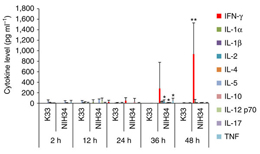Research Abstract
インターフェロンγを産生する未成熟骨髄細胞は劇症型A群レンサ球菌感染に対して防御的に働く
Interferon-γ-producing immature myeloid cells confer protection against severe invasive group A Streptococcus infections
2012年2月14日 Nature Communications 3 : 678 doi: 10.1038/ncomms1677

サイトカインにより活性化された好中球はA群レンサ球菌(Streptococcus pyogenes)感染に対する宿主防御に不可欠である。しかし、好中球減少を伴う劇症型A群レンサ球菌感染症の際には、感染に対してどのような因子が防御に関与し、どの細胞集団がそれを供給するのかは不明である。本論文では、劇症型A群レンサ球菌単離株に感染したマウスでは、感染の初期段階に血漿中のインターフェロンγ濃度が高くなるが、非劇症型A群レンサ球菌単離株感染の場合にはこうした上昇が見られないことを示している。インターフェロンγは感染からマウスを防御するために必要であり、これを産生する細胞は、顆粒球-マクロファージコロニー刺激因子依存性で、リング状の核を持つ未成熟骨髄細胞の新規集団である。これらのインターフェロンγ産生未成熟骨髄細胞は、単球および顆粒球のマーカーを発現しており、一酸化窒素も産生する。インターフェロンγ産生未成熟骨髄細胞の養子移入によって、野生型マウスおよびインターフェロンγ欠損マウスで感染が改善される。我々の結果は、インターフェロンγ産生未成熟骨髄細胞が、劇症型A群レンサ球菌感染の初期段階で防御的な役割を果たすことを示している。
- 国立感染症研究所 免疫部
- 国立感染症研究所 細菌第一部
Cytokine-activated neutrophils are known to be essential for protection against group A Streptococcus infections. However, during severe invasive group A Streptococcus infections that are accompanied by neutropenia, it remains unclear which factors are protective against such infections, and which cell population is the source of them. Here we show that mice infected with severe invasive group A Streptococcus isolates, but not with non-invasive group A Streptococcus isolates, exhibit high concentrations of plasma interferon-γ during the early stage of infection. Interferon-γ is necessary to protect mice, and is produced by a novel population of granulocyte–macrophage colony-stimulating factor-dependent immature myeloid cells with ring-shaped nuclei. These interferon-γ-producing immature myeloid cells express monocyte and granulocyte markers, and also produce nitric oxide. The adoptive transfer of interferon-γ-producing immature myeloid cells ameliorates infection in wild-type and interferon-γ-deficient mice. Our results indicate that interferon-γ-producing immature myeloid cells have a protective role during the early stage of severe invasive group A Streptococcus infections.

